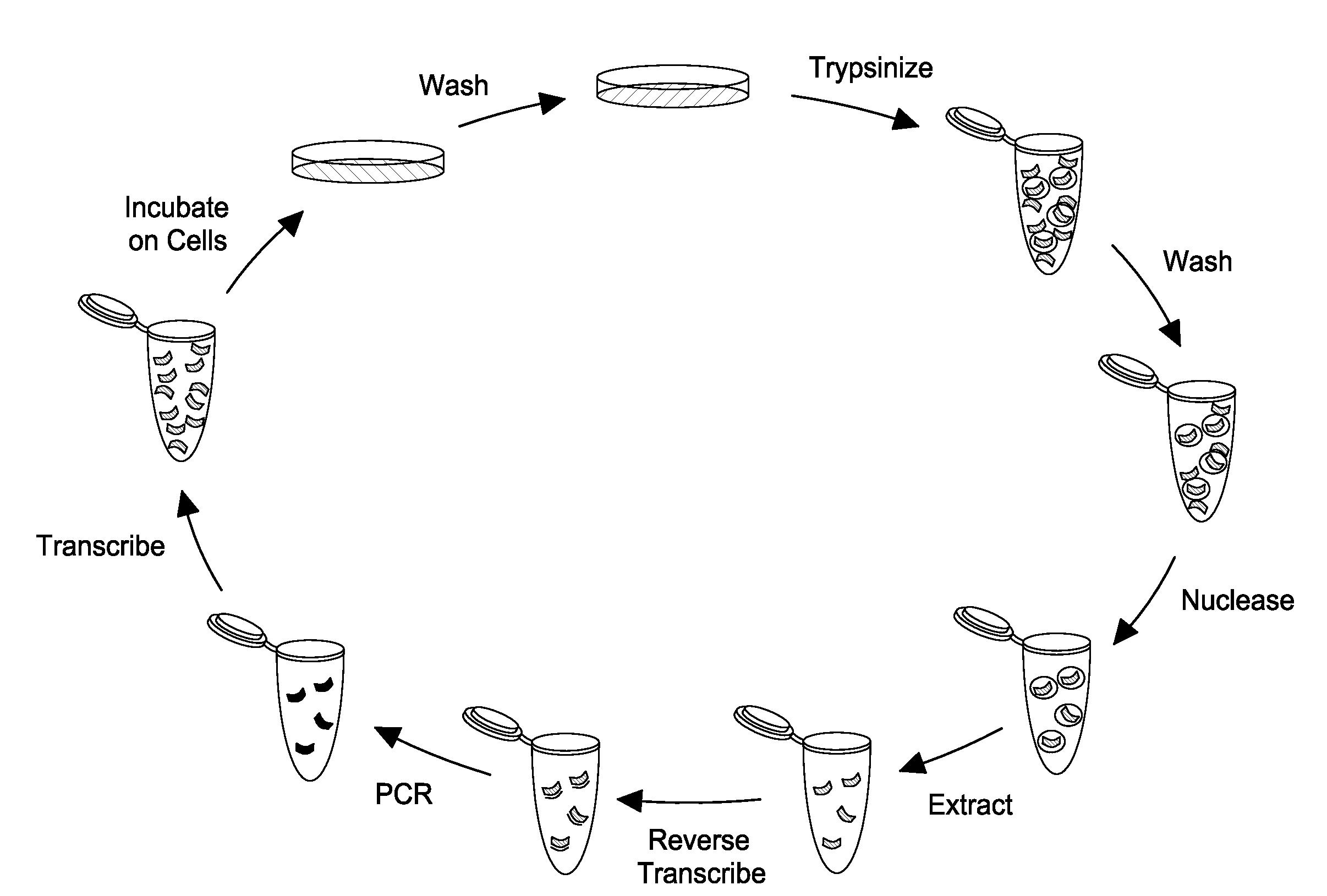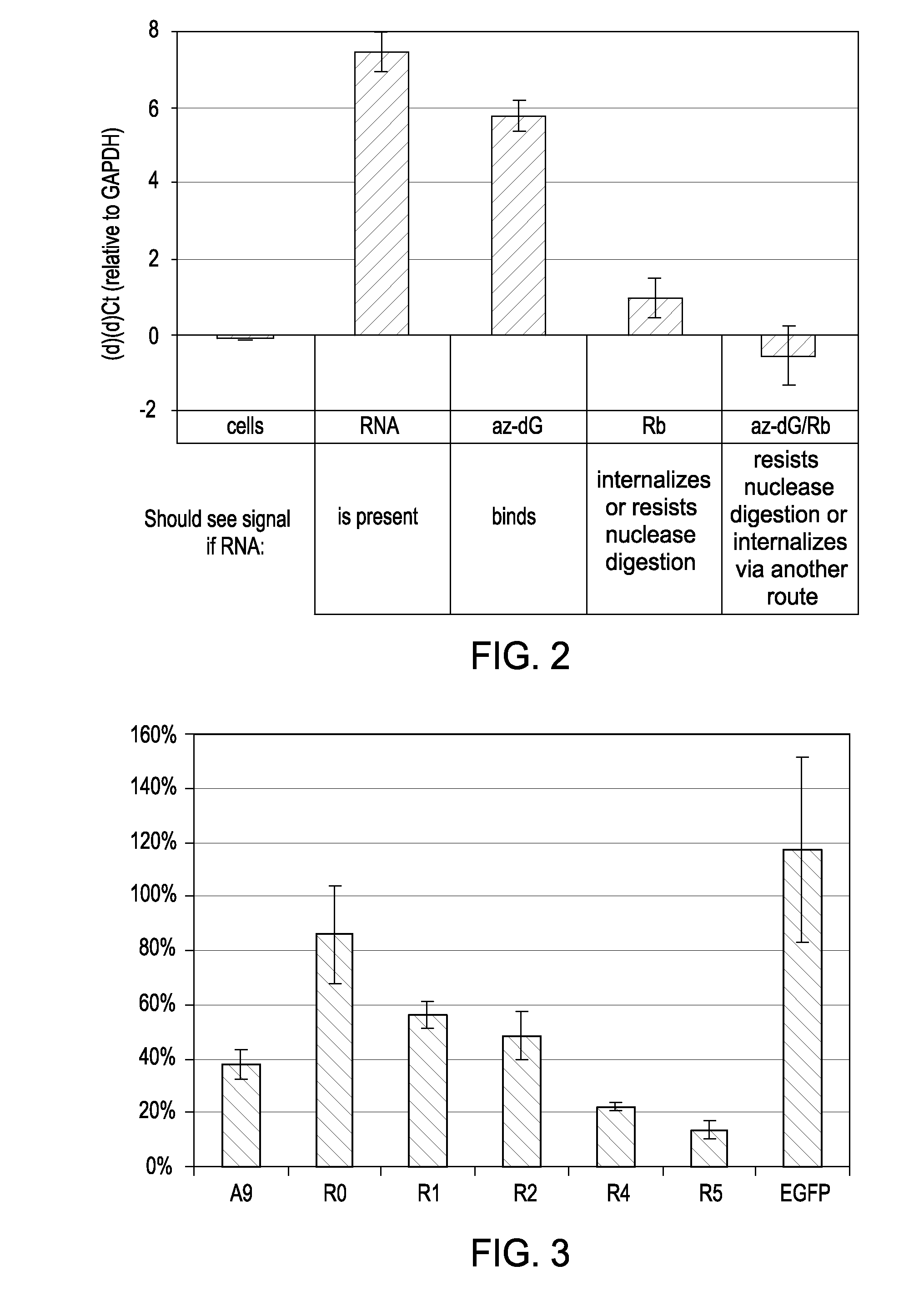Selection Method for Cell Internalizing Nucleic Acids
a nucleic acid and cell technology, applied in the field of molecular biology and biochemistry, can solve the problems of toxic agents delivered into cells, inefficient or highly non-specific, and often toxic delivery mechanisms, and achieve the effect of reducing toxicity and non-specific effects on the organism
- Summary
- Abstract
- Description
- Claims
- Application Information
AI Technical Summary
Benefits of technology
Problems solved by technology
Method used
Image
Examples
example 1
1. Sequences and Primers.
[0083]The N30 pool used for these selections had the following sequence:
(SEQ ID NO.: 1)5′GGGAATGGATCCACATCTACGAATTCNNNNNNNNNNNNNNNNNNNNNNNNNNNNNNTTCACTGCAGACTTGACGAAGCTT 3′;
[0084]where N is any of the four bases. The pool was synthesized and purified as described below. Amplification primers for the N30 pool were as follows:
(forward) 41.30:(SEQ ID NO.: 2)5′GATAATACGACTCACTATAGGGAATGGATCCACATCTACGA 3′;(reverse) 24.30:(SEQ ID NO.: 3)5′ AAGCTTCGTCAAGTCTGCAGTGAA 3′;
[0085]The template for the anti-PSMA aptamer, A9, used in these assays had the following sequence:
(SEQ ID NO.: 4)5′GGGAGGACGAUGCGGACCGAAAAAGACCUGACUUCUAUACUAAGUCUACGUUCCCAGACGACUCGCCCGA 3′,;
[0086]where the underlined sequences represent constant regions used to amplify the aptamer. Amplification primers for A9 were as follows:
(forward)(SEQ ID NO.: 5)5′ TTCTAATACGACTCACTATAGGGAGGACGATGCGG 3′;(reverse)(SEQ ID NO.: 6)5′ TCGGGCGAGTCGTCTG 3′;
[0087]All primers and the A9 template were ordered from IDT (Cora...
example 2
1. Identification of RNA-Containing Molecules.
[0105]An internalizing RNA sequence, the anti-PSMA aptamer, A9, was used to test the novel conditions disclosed herein, and to identify RNA-containing molecules and ensure survival of internalizers.
[0106]FIG. 1 shows the effectiveness of the nucleasing conditions. Approximately 106 LnCap cells were treated with one of four conditions: anti-PSMA aptamer was added directly to media on cells (RNA); cells were first treated for 10 minutes with 10 mM sodium azide and 50 mM deoxyglucose to prevent endocytosis, then RNA was added to the media after washing (az-dG); RNA was added to cells, and then cells were nuclease treated with 0.02 U / uL Riboshredder (Epicentre) to digest binders (Rb); or cells were treated with az-dG before adding RNA, and cells were nuclease treated after RNA digestion. Each treatment was done in triplicate. Total cell RNA from each of the treatments was reverse-transcribed with aptamer-specific primers, and real-time PCR c...
example 3
1. Identification of RNA-Containing Molecules
[0110]An internalizing RNA sequence, the anti-PSMA aptamer, A9, is used to test the method of iteratively decreasing the length of time that cell are contacted with a RNA-containing molecule. The conditions and reagents are identical to those described above.
2. Selection
[0111]The selection conditions are substantially similar to those disclosed above. Briefly, a doped, 2′-fluoro-modified RNA pool based on the A9 aptamer, wherein each base position of the aptamer is doped by about 30%, is used to test the selection scheme proposed herein. Three to five micrograms of the doped PSMA pool is added to LnCap cells at 70-80% confluency in a T25 flask, and cells are incubated overnight. Cells are then washed with PBS and are treated with 0.01 U / μL Riboshredder in PBS for 10 min. Cells are washed three times and total cellular RNA is extracted with 1 mL Trizol. The recovered RNA is reverse transcribed and is amplified via PCR to generate template ...
PUM
| Property | Measurement | Unit |
|---|---|---|
| volume | aaaaa | aaaaa |
| volume | aaaaa | aaaaa |
| volume | aaaaa | aaaaa |
Abstract
Description
Claims
Application Information
 Login to View More
Login to View More - R&D
- Intellectual Property
- Life Sciences
- Materials
- Tech Scout
- Unparalleled Data Quality
- Higher Quality Content
- 60% Fewer Hallucinations
Browse by: Latest US Patents, China's latest patents, Technical Efficacy Thesaurus, Application Domain, Technology Topic, Popular Technical Reports.
© 2025 PatSnap. All rights reserved.Legal|Privacy policy|Modern Slavery Act Transparency Statement|Sitemap|About US| Contact US: help@patsnap.com



